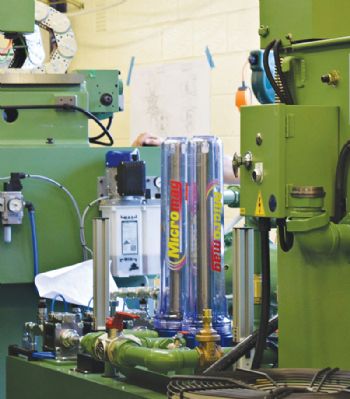
Precision mechanical engineering company Mollart Engineering Ltd is now installing magnetic filters on most of the multi-spindle gun-drilling machines that it supplies to the ‘pellet industry’.
The company manufactures the machinery used to make dies that create pellets from a variety of materials; these include wood and coal — and the ingredients for animal feed.
One of the main materials used to make the dies is a chrome alloy steel — XC40 — that naturally produces a large amount of dust when drilled at high feed rates.
This dust contaminates the cutting oil used when machining, resulting in particles that settle in the coolant tank and create a thick paste-like substance that blocks the coolant pump, rendering it useless.
Mollart has found a solution to this problem — the Micromag magnetic filter from Eclipse Magnetics (
www.spearandjacksongroup.com). This unit efficiently filters the oil to remove the damaging particulate.
Ian Petitt, Mollart Engineering’s sales director, said: “We have had considerable success with Micromag in this application. It has resolved a lot of problems, and not many machines now go without it.
The XC40 chrome-alloy steel is a martensitic material that contains chrome, which is non-magnetic. However, the ferrite particulate that is collected gathers to form a ‘beard’ on the magnets within the filter, which helps to catch even the non-magnetic particles.”
In some systems, a series of six Micromag MM20s is used as a pre-filter to reduce the cost and usage of the paper media. The flow rate of the systems is up to 300 litres per min; and as the Micromags have a flow rate of 90 litres per min (with three in action and three on standby), a change-over mechanism (a three-way valve) allows the Micromags used to be changed over live without stopping the equipment, enabling uninterrupted 24/7 production.
Cost savings
Pumps cost about £3,000 each (as a minimum) — and up to £5,000 for larger ones. Customers using paper filters as a primary method of filtration alone often experience problems with the build-up of dust and debris in the machine, putting pumps at risk; a secondary filter was therefore required to remove sub-micron particulate from the oil.
Mr Pettit says: “The good thing about Eclipse filters is that you don’t have disposable filtration elements, and that makes a big difference to disposal costs and general running costs.
“My main aim is to make sure my customers’ pumps work and ‘stay alive’ for as long as possible. Pumps are very costly pieces of equipment, and when they go down, it puts a huge amount of stress on the business. The Micromag prevents that situation. I recently liaised with a customer in France that was using one of our gun-drilling centres.
“The material they were using was creating a lot of dust during the drilling process. They initially ran the machine using 20µm filter paper, which was doing its job to start with, but six months down the line it was being choked by dust. We installed a Micromag, which eradicated the problem. Wherever there is a dust problem when drilling ferritic material, the Micromag can be very useful.”
One of the biggest applications for this type of Mollart drilling machine is making pellets for biomass boilers. These pellets are made by pushing wood pulp through a die. The holes machined in the die are drilled using a Mollart gun-drilling centre; and depending on what the die is going to be used for, up to 200,000 holes may be required on a single die.
Some dies can produce several hundred tonnes of pellets an hour; this high level of use means that dies wear out, need replacing and are considered as consumables.
Moreover, the fact that these holes need to be drilled accurately and with a good surface finish (to minimise the heat generated in the extrusion process) means that drills need to be kept in good condition and that the machining oil needs to remain clean.